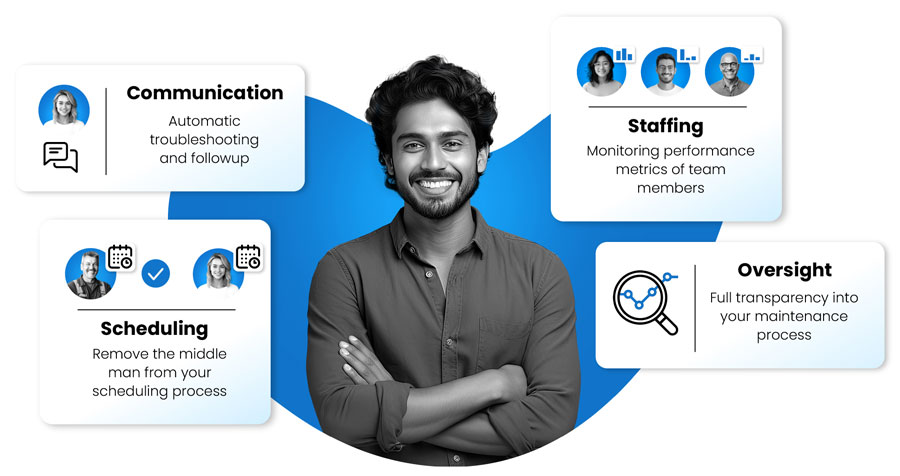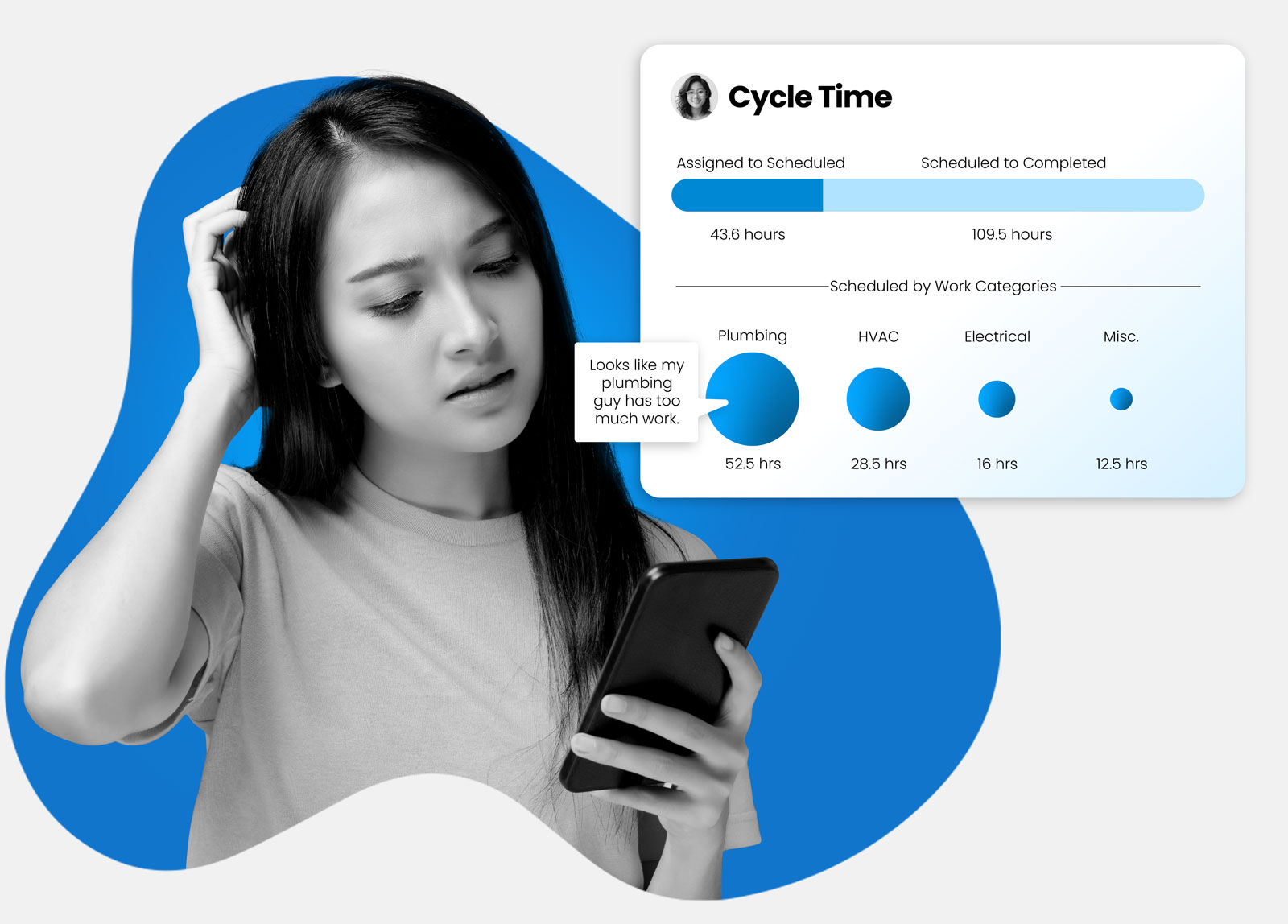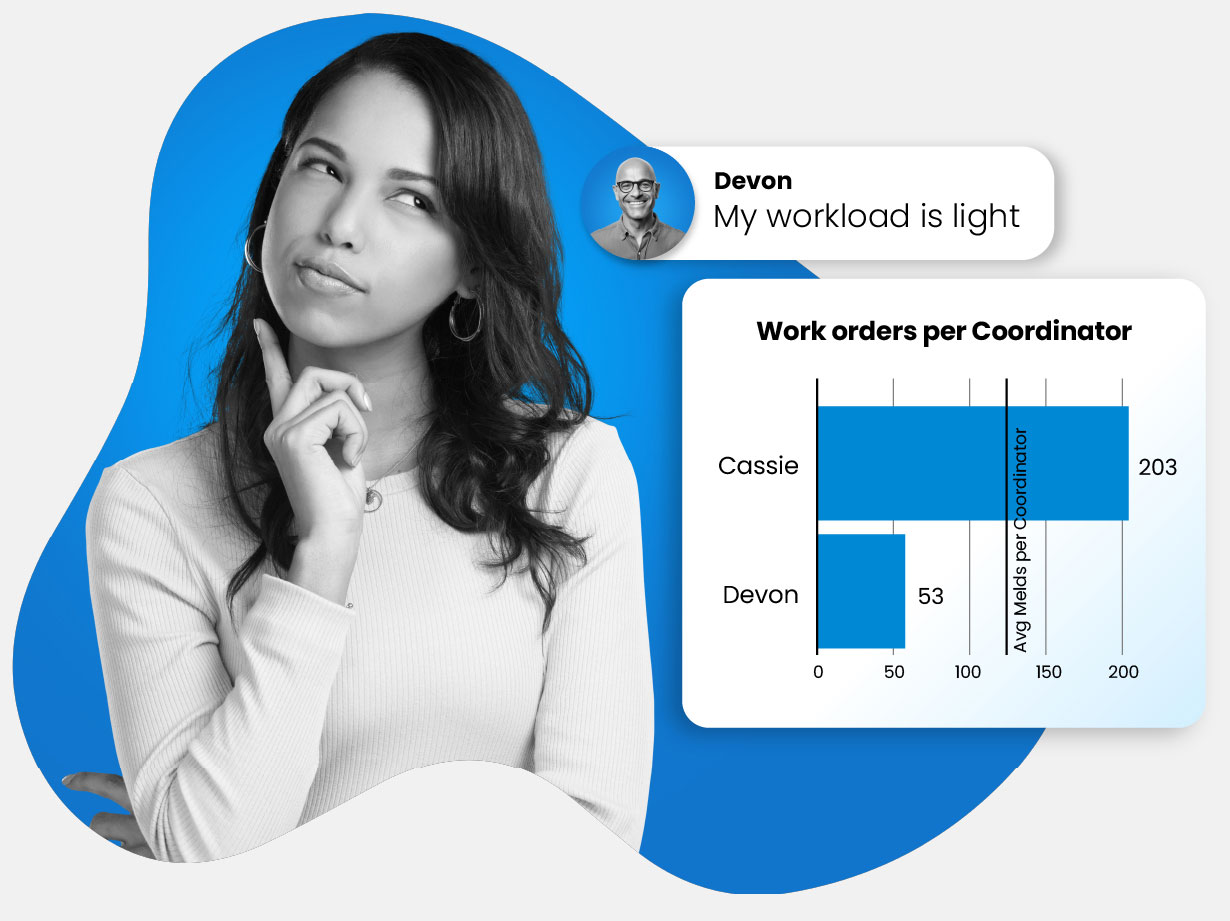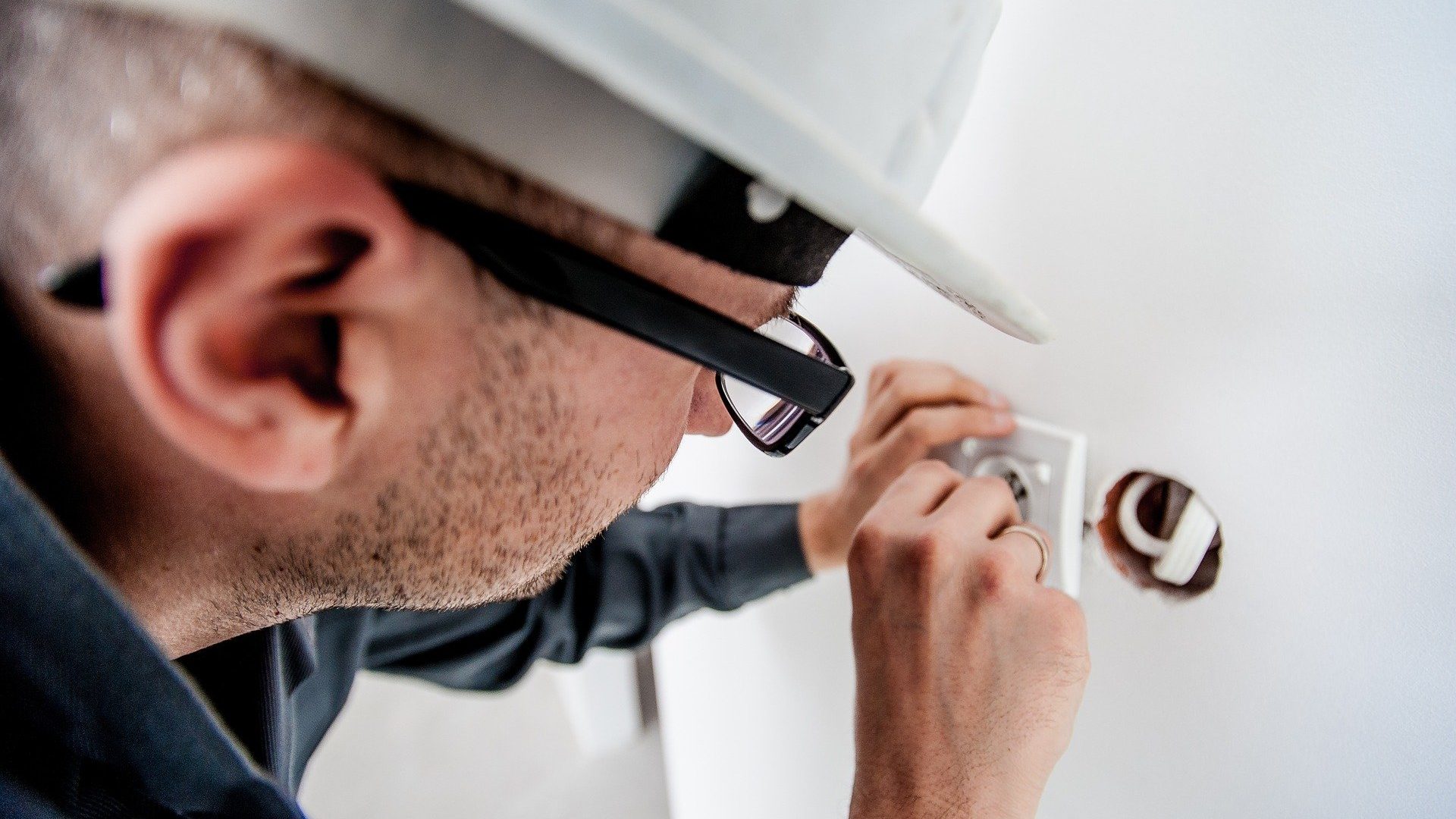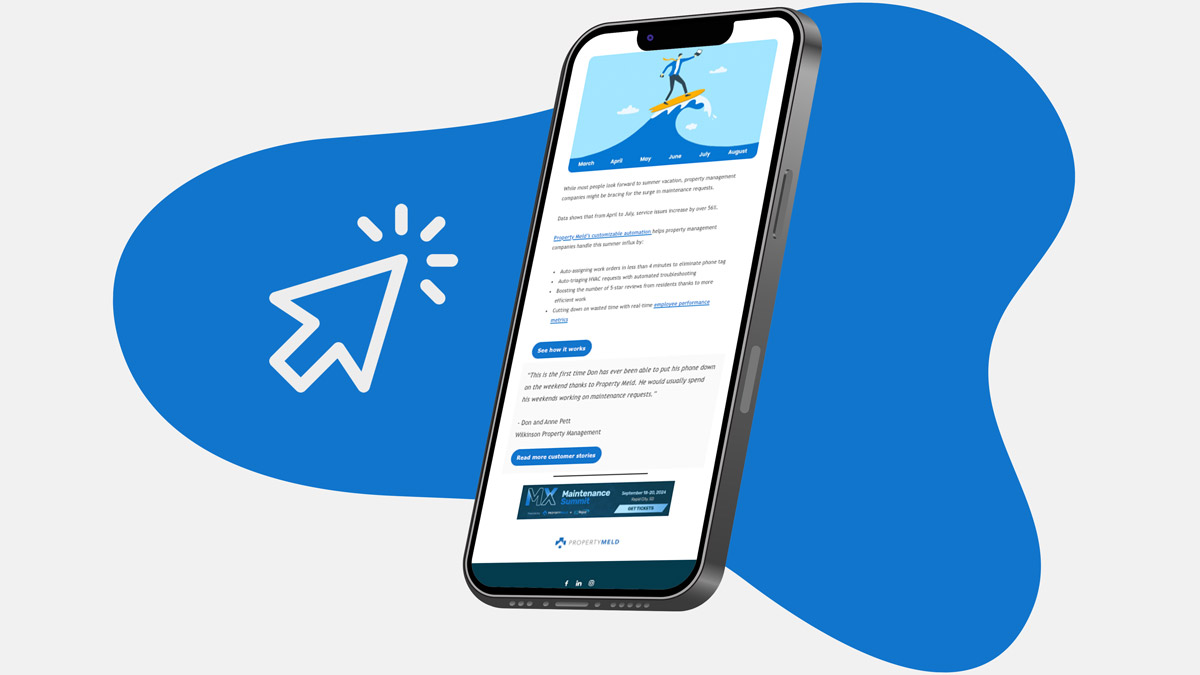Table of Contents
The fear of the unknown is always scary, and property maintenance is no exception. In property management, it’s imperative to thrive in property maintenance to succeed in the industry. The bottom line? Property maintenance matters. It’s one of the most critical elements in daily operations.
This article will serve as the ultimate guide to property maintenance, including a home maintenance checklist of the ten most common maintenance issues, the four main types of maintenance, how property maintenance can be a profitable lever in your business, and more. Afterward, property maintenance will no longer be a scary unknown but a vital responsibility you’re ready to tackle.
What is property maintenance?
Property maintenance is the general upkeep of a property such as repairs, improvements, and preservation of a residential unit. Developing a streamlined maintenance process is essential to a property management company’s success and, if done right, can also be a profit center. You can expect maintenance to be a requirement at every property your company manages. Property maintenance responsibilities can include:
- Regular inspections and routine maintenance to ensure that all electrical and plumbing are operational.
- Upkeep and landscaping
- Building repairs
- Safety checks, such as testing of fire alarms and extinguishers to ensure the single-family home or residential unit is habitable.
- Rodent and pest control
- Completing turnover maintenance during a move-out
What is the importance of property maintenance?
Property maintenance plays an essential role in nearly every aspect of property management. First and foremost, property maintenance plays a huge part in resident satisfaction. One of the reasons people choose to rent instead of owning a home is to avoid dealing with maintenance issues. When residents submit a maintenance request, they assume it will be handled quickly. If it is difficult to submit a request, they don’t hear back, or the scheduling process is a hassle, residents will soon grow dissatisfied, increasing resident turnover.
In addition to resident satisfaction, a streamlined maintenance process will lead to stronger, longer-lasting relationships with property owners. Property owners expect the property management company they choose to manage their properties is taking care of their assets and avoiding high monthly maintenance costs. A good property manager can show owners their ability to not only save them money with property maintenance, but make money.
By prioritizing the maintenance process, and working to make the maintenance team as efficient as possible, asset life is prolonged, and costly damages and repairs can be avoided.

Property maintenance services
Property managers are incredibly busy, and there are a lot of tasks that go into running a successful property management company. From finding and screening potential residents to leasing and maintaining relationships with property owners, it feels like there are not enough hours in the day to get everything done. When things get busy, we see property maintenance slip, although it is one of the most critical aspects of property management.
Staying organized and on top of maintenance can help stop things from falling through the cracks — giving more time back in the day to focus on other important jobs. Typical property maintenance services can often be grouped by season, and creating a seasonal checklist can be a great way to prepare maintenance coordinators and other team members for what’s to come.
Spring: As the weather starts to warm back up, you may notice property damage from snow, wind, and extreme cold temperatures.
- Check for exterior damage on buildings, patios, and common areas
- Change air filters and inspect HVAC systems to prolong the life of the equipment
- Check gutters and downspouts for blockages
- Inspect the roof of properties to ensure there aren’t any leaks or damage
Summer: With the summer months come more maintenance issues. Most people often spend more time indoors due to warmer temperatures and are more likely to notice issues they may have previously overlooked.
- Test smoke alarms and replace fire extinguishers
- Clean window wells and gutters
- Look for any gaps that could allow pests in and spray around the building exterior
- Trim trees to avoid damage during storms
- Maintain landscaping and increase watering during hotter months
Fall: Just like spring, fall is a transitional season and there are many things that need to get done around the property before the cold weather sets in.
- Make sure roofs are in good condition, gutters are clear, and sprinklers are winterized
- Line up snow removal if you are going to hire an outside contractor
- Inspect HVAC and furnaces and replace filters
- Check the insulation in the properties to avoid bursting pipes
For a complete fall maintenance checklist, check out this article.
Winter: With the colder weather, comes more opportunity for maintenance issues to arise. Maintenance is especially important during this time, as issues can quickly become hazardous in extreme temperatures. Winter storms can also wreak havoc on building exteriors.
- Insulate water pipes to prevent them from freezing
- Maintain and service furnaces regularly to avoid equipment failure
- Make sure there is protocol for clearing and salting walkways during storms
- Inspect vacant units to ensure there aren’t burst pipes or snow accumulation.
Maintenance is a consistent responsibility; every season brings different maintenance issues with it. Knowing what to expect can help the maintenance team prepare. By developing a preventative maintenance plan, you can establish processes to inspect and service equipment to avoid costly maintenance emergencies.
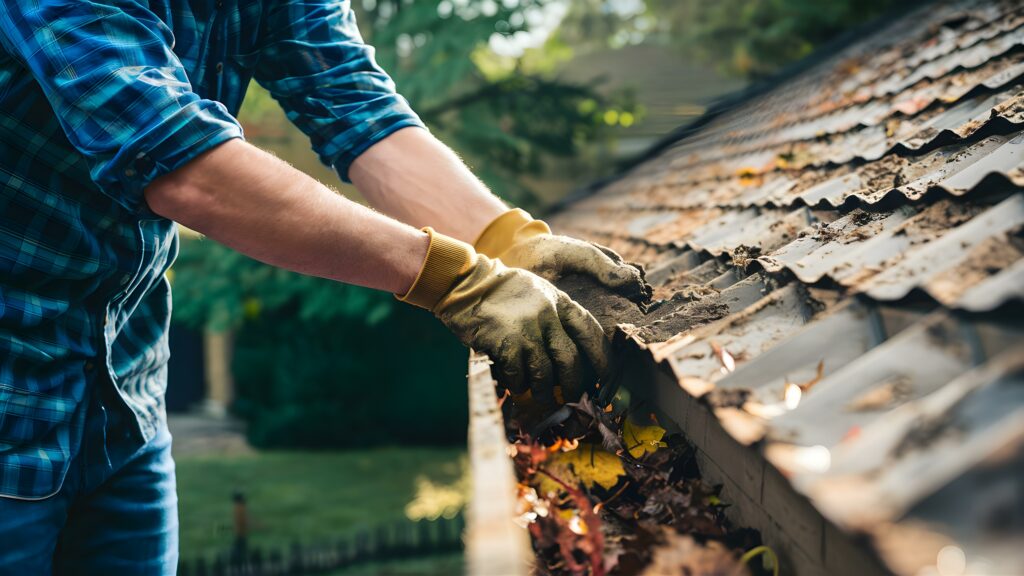
Top 5 Common maintenance issues
Property Meld compiles data from millions of work orders submitted through our platform by residents from all over the country. With this data, we have identified the most common maintenance issues most property management companies will have to deal with. Whether you manage single-family homes or multi-family units, you are likely to experience at least some of these common maintenance issues.
- Conditioning: Half of all HVAC service requests happen in the three months when summer arrives. Temperatures rise, and air conditioning units must work harder to keep units cool. Establishing a process to schedule HVAC repairs is essential to keeping staff from getting burnt out, leading to service delays and angry residents. As I’m sure we all know, there is nothing worse than sitting in a sweltering building without air conditioning.
- Doors: As a property management company, having a locksmith or a maintenance tech available after hours is essential to resident satisfaction. Often residents may lock themselves out, but sometimes they have their key, and there is an issue with the deadlock. Imagine how frustrating it would be as a resident not to be able to get into your own home.
- Toilets: Clogs and other toilet issues may seem like an easy fix, and they often are. But toilet issues left unattended can lead to much more significant problems. Unaddressed leaks or clogs can lead to flooding and water damage. This can be especially catastrophic in an apartment unit as flooding or leaks may damage the unit below.
- Sinks: A leaky sink may not seem like a big deal, but sink problems can be challenging to identify. This means a plumber may take multiple visits to a residence to locate and fix the problem. This means you’ll be paying for numerous trip charges and scheduling multiple visits between the vendor and the resident. By implementing maintenance troubleshooting, you can get more information from a resident beforehand, making it easier for the vendor to diagnose and fix the problem.
- Refrigerators: Refrigerator failures are costly because, most times, they require a specialist, or worse case scenario, buying a new fridge altogether. Diagnosing and fixing refrigerator problems quickly is imperative to maintain a good relationship with residents. Residents will not be pleased if they have to toss out a week’s worth of groceries because a repair took too long.
For a complete list of common maintenance problems, check out this article.
By understanding the most common work orders, teams can plan ahead and develop a system to track servicing and the predictions of a unit’s appliances. In addition, having a system to track a repair job from start to finish can help keep residents happy and provide more insight the next time a similar issue arises.
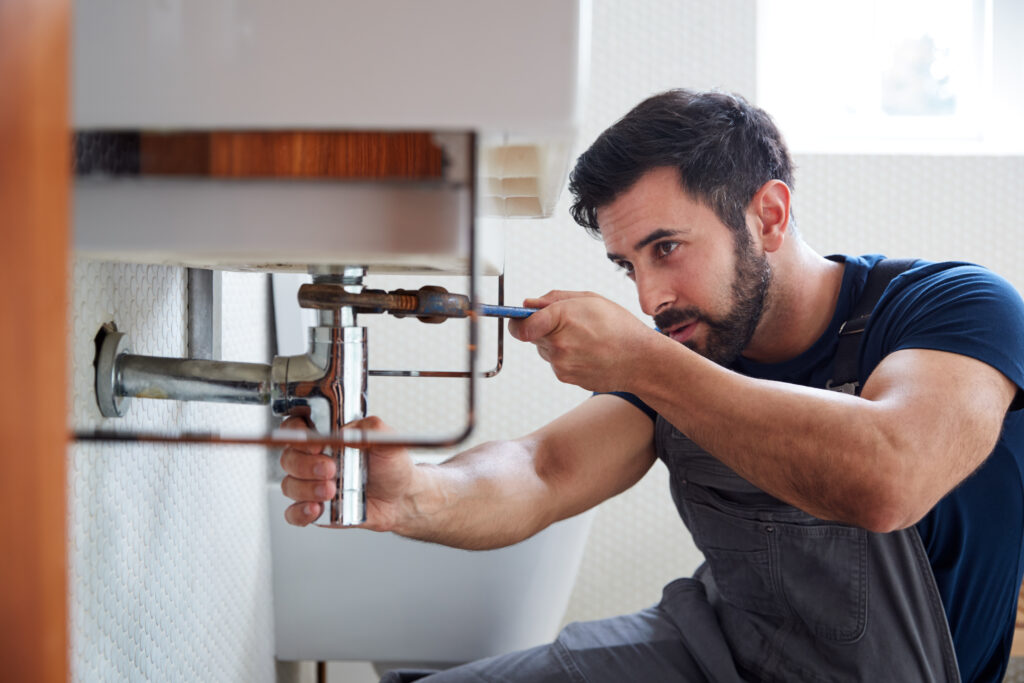
Property maintenance best practices
There are many phases and aspects of the property maintenance process, and adopting best practices into your maintenance process can help a maintenance team run more efficiently and eliminate unnecessary costs. An efficient process keeps costs low, creates a better experience for residents, and keeps property owners satisfied.
• Touch base with the vendor to confirm scheduled repair
Whether manually or with software, take a few moments to confirm with your vendor that the repair has been scheduled on the correct date. It can be as simple as drafting a text or email and plugging in the appointment time.
We recommend you do not wait any longer than 24 hours after a vendor accepts a job before confirming the scheduled appointment. Waiting too long may result in maintenance tasks falling through the cracks.
• Communicate with residents promptly
In addition to touching base with the vendor or technician, a brief check-in with the resident can greatly increase customer satisfaction. Confirming the repair appointment will make them feel taken care of. We understand it might not feel important, but that 3-minute check-in will go a long way.
• Request confirmation of completion from the vendor
Too many property managers rely on an invoice to verify that a work order is complete.
Why is that an issue? Sometimes, receiving an invoice can take weeks. Suppose you fail to confirm with a vendor that a job was complete. Ultimately, you’re setting yourself up for failure, negative reviews, headaches, and lost revenue.
Ask your vendors to follow up with you once they’ve completed the work order. Verbal confirmation is acceptable, but written communication is the best option. Why? Because conversations can be easily forgotten and challenging to track.
• Follow-up on resident satisfaction
Once a repair is complete, you have the green light to ask the resident about the quality of the work. It’s essential to catch complaints early before an unhappy resident leaves you a negative online review. Reputation is everything!
You can’t afford negative feedback. In fact, 78% of prospective residents say a property management company’s online reviews were the number one factor in choosing where to live.
An all-in-one maintenance system can provide streamlined communication throughout the process, so you don’t miss a beat.
• Schedule preventative maintenance
When you schedule preventative maintenance, you remove the hassle of making a costly emergency repair down the road and risking resident satisfaction.
Suppose one of your priority goals this year is to increase resident retention. In that case, a preventive maintenance strategy is a clear winner because it will allow you to control maintenance before issues arise.
For example, your residents are frustrated with broken A/C units in the heat of summer.
Start by scheduling simple preventative tasks like inspecting HVAC systems and replacing HVAC air filters every quarter before peak season hits. Creating a preventative maintenance checklist can help you stay up-to-date on maintenance, prolong the life of your equipment, and keep tabs when it is time to replace the HVAC.
What are the responsibilities of property managers?
A property manager is an individual or company hired by a property owner to oversee and manage their investment. Property owners may hire a property manager for a variety of reasons. First, owners may live far from their properties, so they must hire someone to watch over their assets. Second, many property owners hire a property manager because they don’t have time to manage it themselves. Because they may have full-time jobs, and real estate is just a side investment. The benefit of hiring a property manager is that they have a deep understanding of the industry and know how to handle their investment correctly.
One of the common responsibilities of a property manager is to market the property and attract high-quality tenants. An experienced property manager knows how to highlight a property’s features and attract the right kind of tenants. Property managers will also handle the screening of tenants, from background checks and verifying their income.
Property managers are also expected to collect rent payments. Some property management companies may do this through an online portal, and some may have residents mail in rent checks or pay over the phone. They will also work to remind tenants about upcoming payment dates, late fees, and eviction notices if necessary.
Property managers are also responsible for overseeing the maintenance process. Whether they hire work out from third-party vendors or run an internal maintenance team, property owners work to ensure the maintenance process is efficient and as low-cost as possible. If done right, maintenance can be leveraged as a profit center by property managers looking to obtain more owners.
The most significant benefit to hiring a property manager is the freedom it gives owners. A property manager will become the point of contact for tenants. This saves property owners from being bogged down by calls and emails from residents. Property managers will handle all resident issues and any questions they may have.
What are the different types of maintenance?
Now that you understand what property maintenance is, what property managers are responsible for, and what to do to improve the maintenance process, it’s time to learn the different types of property maintenance.
1. Reactive Maintenance: Reactive maintenance, also known as corrective maintenance, is carried out following the detection of an issue or a work order being submitted. Put simply, maintenance is done when something is broken.
2. Preventative Maintenance: Maintenance is carried out at specific times to reduce the risk of equipment failure. Meaning, maintenance is done before something breaks to help improve the lifetime of your assets.
3. Risk-Based Maintenance: Risk-based maintenance is a principle that states maintenance resources should go towards the assets that would have the most risk associated if they fail. For example, HVAC system issues have the biggest impact on resident satisfaction, so ensuring they are in a good condition should be a top priority of your maintenance team.
4. Condition-Based Maintenance: Maintenance is only done when certain indicators show signs of an upcoming equipment failure of decreasing performance. For example, this could mean monitoring pressure readings on a water system so staff can identify a leak.
How to profit from Property Maintenance Services?
When evaluating your property maintenance services, it is essential to track the profitability of vendors and internal techs. You can track profitability with two metrics: utilization rate and billable rate. These formulas are important because inefficient processes can become costly.
Every hour you pay an internal tech that is not actively making repairs is money coming out of your profit margin.
Let’s take a closer look at these two formulas:
Utilization rate formula
Total Hours checking-in on Service Issues/Total Hours Worked (payroll) = a percentage indicating how much time the employee is physically working on jobs.
It’s important to consider the utilization rate to understand the efficiency of your internal technicians. We recommend a utilization rate of 75% or more for internal technicians for a property management company to profit from their employees.
If one or more internal technicians’ utilization rate is less than 75%, consider why this is. Do you have more technicians than maintenance repairs to go around?
If one or more technicians’ utilization rate is more than 90%, it’s best to shift workload to technicians with a lower utilization rate.
If all your technicians’ utilization rate is more than 90%, that’s great. It’s time to consider hiring another technician for your team.
Likewise, another critical metric to keep track of is the billable rate.
Billable rate formula
Total Hours Billed/ Total Hours Worked (payroll) = A percentage of time worked that generated revenue for the company
This metric helps understand the percentage of time worked that generated revenue for the company. If your internal technician spends most of their hours performing office tasks instead of making repairs, consider alternatives for maintenance management.
In addition to tracking your utilization and billable rate, you can also increase the profitability of your maintenance process by implementing preventative maintenance to reduce the number of costly emergency repairs. In addition, setting up maintenance troubleshooting is a great way to reduce unnecessary trip charges and increase the efficiency of your maintenance team. Lastly, by utilizing designated maintenance software, you can have complete oversight of your maintenance process and automate the mundane tasks slowing up your team.
Property maintenance is a huge aspect of running a successful property management company. By taking control of your maintenance, you can keep residents happy, impress your owners, and have more time to focus on growing your portfolio. With Property Meld you can automate the mundane, leaving you more time to focus on what matters most to your business’s bottom line. To learn more, book a demo with one of our maintenance experts.
